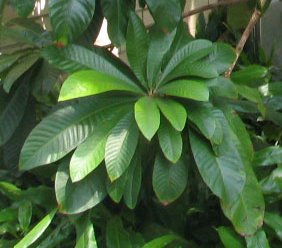
Eupomatia laurina, commonly named bolwarra or sometimes native guava or copper laurel, is a species of shrubs to small trees, of the Australian continent ancient plant family Eupomatiaceae. They often grow between 3 and 5 m tall, larger specimens may attain 15 m (50 ft) and a trunk diameter of 30 cm (12 in). They grow naturally in eastern Australia and New Guinea. In Australia, they grow as far south as Nowa Nowa in the humid forests of the warm temperate east of the state of Victoria through eastern New South Wales and Queensland north to tropical Cape York Peninsula. They are one of the ancient lineages of flowering plants, usually growing as part of an understorey in rainforests or humid Eucalypt forests.
Semecarpus australiensis, the Australian cashew nut, is a species of Australian trees that grow naturally in monsoon forests or rainforests, from sea level to 250 m, often near the sea. It has been found in NT, Cape York, and Queensland wet tropics, Australia, Torres Strait Islands, New Guinea, New Britain, Aru Islands and additional Pacific Islands. It is related to the cashew.

Diospyros pentamera is a common rainforest tree in the Ebony or Persimmon family (Ebenaceae) growing from near Batemans Bay in New South Wales to the Atherton Tableland in tropical Queensland, Australia. It is commonly known as the myrtle ebony, black myrtle, grey plum or grey persimmon.

Jagera pseudorhus, commonly named foambark, is a species of rainforest trees, in the northern half of eastern Australia and in New Guinea, constituting part of the flowering plant family Sapindaceae. Named for the saponin foam that forms on the bark after heavy rain.

Cryptocarya laevigata, known as the glossy laurel or red-fruited laurel, is a rainforest plant growing in eastern Australia. The natural range of distribution is rainforest understorey on fertile soils, from the Richmond River, New South Wales to Cairns in tropical Queensland. Often seen in association with the White Booyong.

Cryptocarya triplinervis is a rainforest tree growing in eastern Australia. Common names include the three veined laurel, three veined cryptocarya and the brown laurel.

Croton verreauxii known as the green native cascarilla is a small tree or shrub growing in dry rainforest and rainforest margins in eastern Australia.
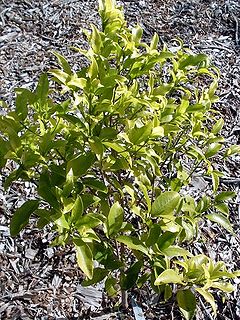
Acronychia baeuerlenii is a rare shrub or small tree growing in the most easterly part of Australia. The Byron Bay acronychia is found between the Richmond River, New South Wales to Lamington National Park just over the border in the state of Queensland.

Planchonella queenslandica, the blush condoo, is a large rainforest tree of the Sapotaceae family native to eastern Australia. It's found in sea side rainforest as well as the drier inland rainforests. From as far south as the Richmond River, New South Wales to Coen in tropical Queensland, and as far west as Melville Island, Northern Territory.

Myoporum acuminatum, commonly known as waterbush, pointed boobialla or mangrove boobialla, is a flowering plant in the figwort family Scrophulariaceae and is endemic to eastern Australia. It grows in rainforest or wet eucalyptus forest near the coast and in the Coastal Ranges, and is occasionally associated with mangroves. Occasionally it is found in the drier rainforests. It grows naturally as far south as Mimosa Rocks National Park in far south eastern New South Wales, and north to Fraser Island in Southern Queensland.
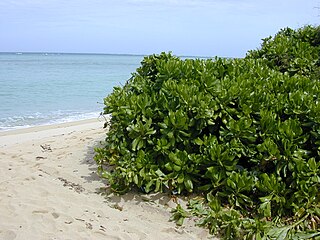
Scaevola taccada, also known as beach cabbage, sea lettuce, beach naupaka, naupaka kahakai (Hawaiian), magoo (Divehi), merambong (Malay), bapaceda or papatjeda, ngahu (Tongan) is a flowering plant in the family Goodeniaceae found in coastal locations in the tropical areas of the Indo-Pacific. It is a common beach shrub throughout the Arabian Sea, the tropical Indian Ocean and the tropical Islands of the Pacific.
Pittosporum wingii, sometimes known as the mountain pittosporum or hairy pittosporum, is a shrub or small tree growing in tropical Queensland in Australia. It may reach 9 metres tall, growing in rainforest or moist eucalyptus areas. It grows in a variety of different sites, in the forest understory from 150 metres to 1100 metres above sea level

Acalypha eremorum is a species of shrubs of the plant family Euphorbiaceae, endemic to Queensland, Australia. Commonly known as soft acalypha, turkey bush or native acalypha. The species grows as an open branched shrub to 2 m tall with small leaves with crenate margins. Plants may shed their leaves in response to prolonged drought. Branches often end in spines, especially on smaller plants. Small flowers are produced in spikes throughout the year and are followed by deeply lobed capsular fruit.
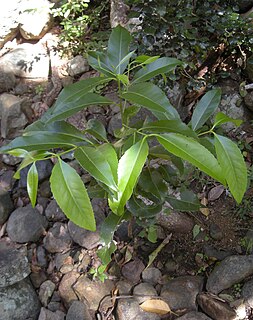
Elaeodendron melanocarpum is a species of shrubs or small trees endemic to northern Australia. The natural range extends from The Kimberley across The Top End to Cape York Peninsula and southwards to South East Queensland. The species occurs in monsoon forest and drier types of rainforests, commonly along streams.
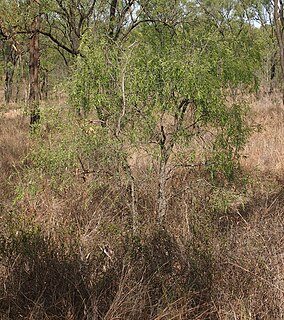
Maytenus cunninghamii is a species of shrub endemic to Australia. The natural range extends from The Kimberley and throughout The Northern Territory and Queensland. The plant grows to 6 metres in height, though it commonly flowers as a much smaller shrub. It is most commonly found in savanna and open forests, though it occasionally extends into monsoon forest.

Exocarpos latifolius is a species of parasitic trees, of the plant family Santalaceae. They have the common names broad leaved ballart, scrub sandal-wood, scrub cherry, oringorin, broad leaved cherry or native cherry. The species is found in monsoon forest, littoral rainforest and occasionally in more open forest types in Malesia and across Northern Australia.

Ehretia saligna, commonly known as peach bush, native willow and peachwood is a species of shrubs or small trees, endemic to Northern Australia. The natural range extends from the Gascoyne, across the Northern Territory throughout northern Queensland and coastal; regions of Southern Queensland and New South Wales.
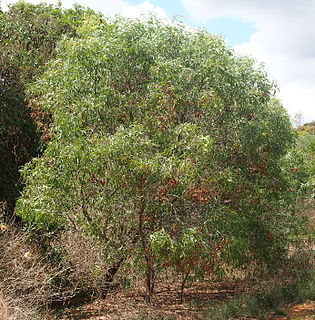
Acacia leptocarpa is a shrub or small tree native to New Guinea and coastal regions of Northern Australia.
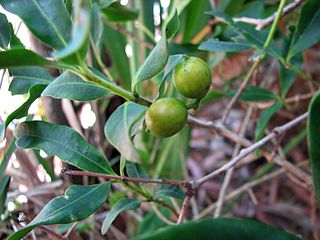
Alyxia spicata, commonly known as chain fruit, is a sprawling shrub or vine in the family Apocynaceae. It is native to New Guinea and the Australian tropics.

Hakea actites, commonly known as the mulloway needle bush or wallum hakea is a shrub or tree of the Proteacea family native to areas in north eastern New South Wales and south eastern Queensland. White nectar rich flowers appear in abundance from late autumn to early spring.

